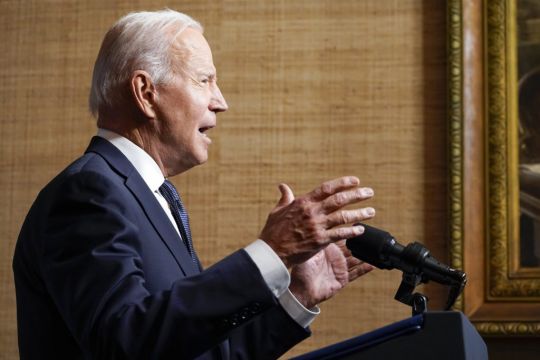President Joe Biden says he will withdraw remaining US troops from Afghanistan, declaring that the September 11 attacks “cannot explain” why American forces should still be there 20 years after the deadliest terror assault on the United States.
His plan is to pull out all American forces — numbering 2,500 now — by September 11 this year, the anniversary of the attacks, which were coordinated from Afghanistan.
The US cannot continue to pour resources into an intractable war and expect different results, Mr Biden said.
It is time to end America’s longest war.
It is time for American troops to come home from Afghanistan.— President Biden (@POTUS) April 14, 2021
Advertisement
The drawdown would begin rather than conclude by May 1, which has been the deadline for full withdrawal under a peace agreement the Trump administration reached with the Taliban last year.
“It is time to end America’s longest war,” Mr Biden said, but he added that the US will “not conduct a hasty rush to the exit”.
“We cannot continue the cycle of extending or expanding our military presence in Afghanistan hoping to create the ideal conditions for our withdrawal, expecting a different result,” Mr Biden said.
“I am now the fourth United States president to preside over an American troop presence in Afghanistan. Two Republicans. Two Democrats. I will not pass this responsibility to a fifth.”
The decision marks perhaps the most significant foreign policy decision for Mr Biden in the early going of his presidency.
He has long been sceptical about the US presence in Afghanistan. As Barack Obama’s vice president, Mr Biden was a lonely voice in the administration who advised the 44th president to tilt towards a smaller counterterrorism role in the country while military advisers were urging a troop build-up to counter Taliban gains.
Mr Biden has also made clear he wants to recalibrate US foreign policy to face bigger challenges posed by China and Russia.
Withdrawing all US troops comes with clear risks. It could boost the Taliban’s effort to claw back power and undo gains toward democracy and women’s rights made over the past two decades.
It also opens Mr Biden to criticism, mostly Republicans and some Democrats, even though former president Donald Trump had also wanted a full withdrawal.
#NATO Allies have decided to start withdrawing @ResoluteSupport forces in #Afghanistan by 1 May, in an orderly, coordinated & deliberate way. We will continue to stand with Afghanistan, this marks a new chapter in our relationship.
Ministerial statement: https://t.co/1c9Y89zJZX pic.twitter.com/L4yIAXMgto— Jens Stoltenberg (@jensstoltenberg) April 14, 2021
Nato chief Jens Stoltenberg later said the alliance has agreed to withdraw its roughly 7,000 forces from Afghanistan to match US President Joe Biden’s decision.
Mr Stoltenberg said the full withdrawal would be completed “in months”, but did not mention the 20th anniversary of the September 11 terrorist attacks set as a goal by Mr Biden.
“We went into Afghanistan together, we have adjusted our posture together and we are united in leaving together,” he said.
Mr Stoltenberg revealed the decision shortly after Mr Biden formally announced his plans and after meeting with Secretary of State Antony Blinken and Defence Secretary Lloyd Austin at Nato headquarters in Brussels.







